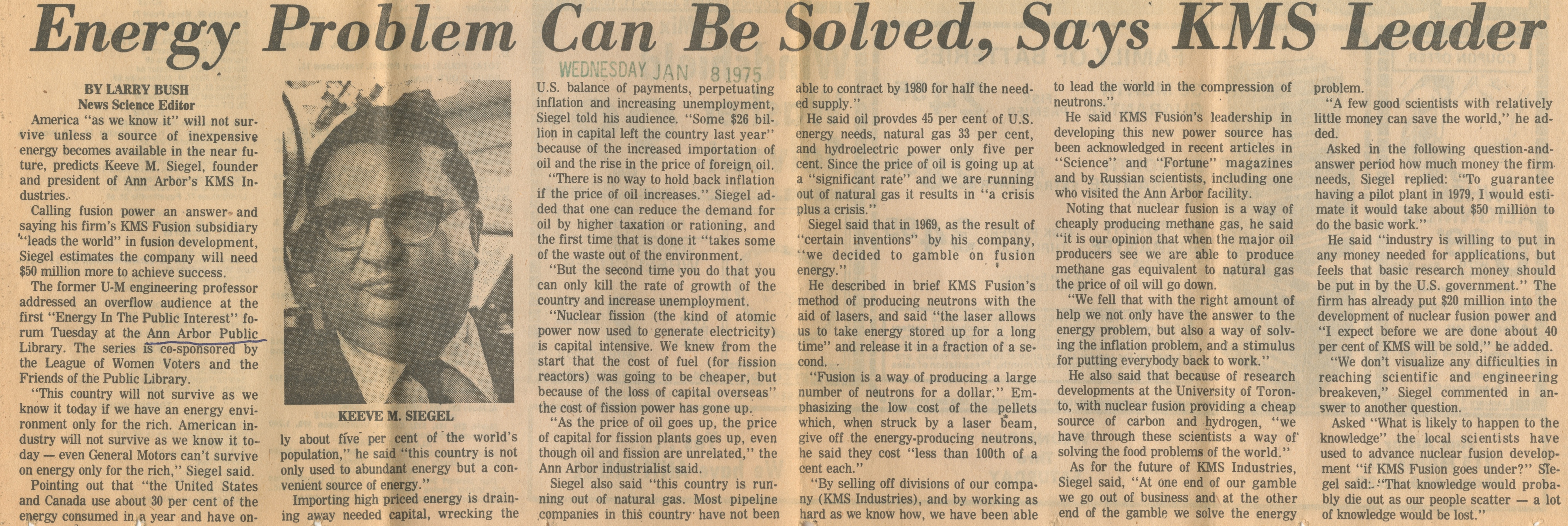Energy Problem Can Be Solved, Says KMS Leader

BY LARRY BUSH
News Science Editor
WEDNESDAY JAN 8 1975
America “as we know it” will not survive unless a source of inexpensive energy becomes available in the near future, predicts Reeve M. Siegel, founder and president of Ann Arbor’s RMS Industries.
Calling fusion power an answer-and saying his firm's RMS Fusion subsidiary ‘“leads the world” in fusion development, Siegel estimates the company will need $50 million more to achieve success.
The former U-M engineering professor addressed an overflow audience at the first “Energy In The Public Interest” forum Tuesday at the Ann Arbor Public Library. The series is co-sponsored oy~ the League of Women Voters and the Friends of the Public Library.
“This country will not survive as we know it today if we have an energy environment only for the rich. American industry will not survive as we know it today — even General Motors can’t survive on energy only for the rich,” Siegel said.
Pointing out that “the United States and Canada use about 30 per cent of the energy consumed in a year and have only about five per cent of the world’s population,” he said “this country is not only used to abundant energy but a convenient source of energy.”
Importing high priced energy is draining away needed capital, wrecking the U.S. balance of payments, perpetuating inflation and increasing unemployment, Siegel told his audience. “Some $26 billion in capital left the country last year” because of the increased importation of oil and the rise in the price of foreign oil.
“There is no way to hold back inflation if the price of oil increases.” Siegel added that one can reduce the demand for oil by higher taxation or rationing, and the first time that is done it “takes some of the waste out of the environment.
“But the second time you do that you can only kill the rate of growth of the country and increase unemployment.
“Nuclear fission (the kind of atomic power now used to generate electricity) is capital intensive. We knew from the start that the cost of fuel (for fission reactors) was going to be cheaper, but because of the loss of capital overseas" the cost of fission power has gone up.
“As the price of oil goes up, the price of capital for fission plants goes up, even though oil and fission are unrelated,” the Ann Arbor industrialist said.
Siegel also said “this country is running out of natural gas. Most pipeline companies in this country have not been able to contract by 1980 for half the needed supply.”
He said oil provides 45 per cent of U.S. energy needs, natural gas 33 per cent, and hydroelectric power only five per cent. Since the price of oil is going up at a “significant rate" and we are running out of natural gas it results in “a crisis plus a crisis.”
Siegel said that in 1969, as the result of “certain inventions” by his company, “we decided to gamble on fusion energy.”
He described in brief RMS Fusion’s method of producing neutrons with the aid of lasers, and said “the laser allows us to take energy stored up for a long time” and release it in a fraction of a second. .
“Fusion is a way of producing a large number of neutrons for a dollar.” Emphasizing the low cost of the pellets which, when struck by a laser beam, give off the energy-producing neutrons, he said they cost “less than 100th of a cent each.”
“By selling off divisions of our company (RMS Industries), and by working as hard as we know how, we have been able to lead the world in the compression of neutrons.”
He said RMS Fusion’s leadership in developing this new power source has been acknowledged in recent articles in “Science” and "Fortune” magazines and by Russian scientists, including one who visited the Ann Arbor facility.
Noting that nuclear fusion is a way of cheaply producing methane gas, he said “it is our opinion that when the major oil producers see we are able to produce methane gas equivalent to natural gas the price of oil will go down.
“We fell that with the right amount of help we not only have the answer to the energy problem, but also a way of solving the inflation problem, and a stimulus for putting everybody back to work.”
He also said that because of research developments at the University of Toronto, with nuclear fusion providing a cheap source of carbon and hydrogen, “we have through these scientists a way of solving the food problems of the world.” As for the future of RMS Industries, Siegel said, “At one end of our gamble we go out of business and at the other end of the gamble we solve the energy problem.
“A few good scientists with relatively little money can save the world,” he added.
Asked in the following question-and-answer period how much money the firm needs, Siegel replied: “To guarantee having a pilot plant in 1979,I would estimate it would take about $50 million to do the basic work.”
He said “industry is willing to put in any money needed for applications, but feels that basic research money should be put in by the U.S. government.” The firm has already put $20 million into the development of nuclear fusion power and “I expect before we are done about 40 per cent of RMS will be sold,” he added.
“We don’t visualize any difficulties in reaching scientific and engineering breakeven,” Siegel commented in answer to another question.
Asked “What is likely to happen to the knowledge” the local scientists have used to advance nuclear fusion development “if RMS Fusion goes under?” Siegel said:. “That knowledge would probably die out as our people scatter — a lot of knowledge would be lost.”
(Photo KEEVE M. SIEGEL)